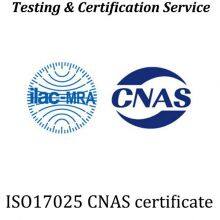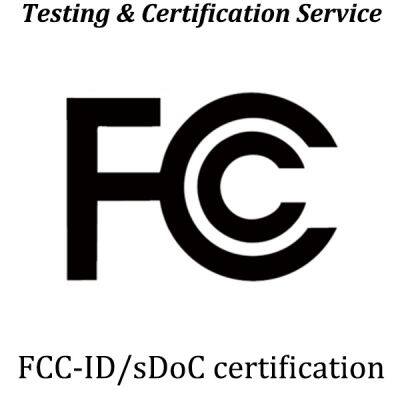FCC Certification/FCC Certification Application Process/FCC ID/FCC SDOC
- 10000 Piece / Pieces per Month
- T/T L/C PayPal D/P Western Union Other
You May Like
-
FCC SDOC/FCC Part15B Report
-
US FDA certification/FDA registration
-
CA65/PROP65 Testing/What is Proposition 65 in California?
-
UL Certification/UL LISTED/UL Recognized/UL Classification/UL Factory Inspection
-
US ETL Certification/Differences between ETL and UL/ETL Certification Application Process
-
US MET Certification/MET Certification Mark/MET Factory Inspection
Product Description
FCC Certification/FCC Certification Application Process/FCC ID/FCC SDOC
FCC Certification Introduction
FCC stands for Federal Communications Commission, which is the Federal Communications Commission in Chinese. Established by COMMUNICATIONACT in 1934, it is an independent agency of the US government and is directly responsible to Congress. FCC coordinates domestic and international communications by controlling radio broadcasting, television, telecommunications, satellites and cables. Involving more than 50 states, Columbia and the United States, the Engineering and Technology Department of the FCC is responsible for the technical support of the Commission and is also responsible for equipment approval. Many radio application products, communication products and digital products require FCC approval to enter the US market.
Certification Type
On November 2, 2017, the Federal Communications Commission (FCC) merged DoC and Verification into SDoC (Supplierâs Declaration of Conformity). SDoC certification will replace FCC Verification and DoC certification procedures. All equipment applicable to FCC Verification and DoC certification procedures can adopt SDoC certification procedures.
FCC has two different certification methods for electronic products: FCC SDoC and FCC ID (Certification). The former is applicable to ordinary products without wireless functions, and the latter is applicable to products with wireless functions.
Applicable product range
1. Power supply: communication power supply, switching power supply, adapter, wireless charging, charger, display power supply, LED power supply, LCD power supply, uninterruptible power supply system UPS, etc.;
2. Lamps: ceiling lamps, wall lamps, chandeliers, track lamps, garden lamps, portable lamps, downlights, street lamps, light strings, table lamps, floor lamps, grille lamps, aquarium lamps, energy-saving lamps, LED street lamps, LED table lamps, LED floor lamps, LED ceiling lamps, LED spotlights, LED bulbs, LED tubes, LED lamps, energy-saving lamps, T8 tubes, etc.;
3. Home appliances: refrigerators, washing machines, electric fans, tower fans, bladeless fans, air conditioners, mobile air conditioners, humidifiers, dehumidifiers, dryers , hanging iron, air purifier, fresh air system, vacuum cleaner, cleaning machine, mite removal machine, sweeping robot, air conditioner, range hood, dishwasher, electric oven, disinfection cabinet, integrated stove, commercial kitchen equipment, electric water heater, air energy water heater, electric faucet, water purifier, water dispenser, juicer, juicer, wall breaker, coffee machine, bread machine, electric oven, air fryer, egg beater, electric stew pot, food processor, rice cooker, yogurt machine, noodle machine, electric pressure cooker, soy milk machine, microwave oven, induction cooker, electric ceramic stove, electric pancake stall, electric kettle, hair dryer, beauty instrument, facial cleanser, curling iron, hair straightener, hair clipper, razor, oral care, epilator, massage chair, massager, weight scale, etc.;
4. Electronics: TV, audio, amplifier, DVD, VCD, projector, camera, monitor, computer, server, scanner, printer, copier, headset, mouse, keyboard, router, mobile phone battery, laser pen, etc.
5. Communication products: telephone, fax machine, telephone recorder, data machine, data interface card and other communication products.
6. Wireless products: Bluetooth BT products, tablet computers, wireless keyboards, wireless mice, wireless readers, wireless transceivers, wireless intercoms, wireless microphones, remote controls, wireless network devices, wireless image transmission systems and other low-power wireless products;
7. Wireless communication products: 2G mobile phones, 3G mobile phones, 3.5G mobile phones, 4GS mobile phones, Internet cards, DECT mobile phones (1.8G, 1.9G frequency), wireless intercoms, etc.;
8. Machinery: gasoline engines, electric welders, CNC drilling machines, tool grinders, lawn mowers, washing equipment, bulldozers, lifts, punching machines, dishwashers, water treatment equipment, gasoline welding machines, printing machinery, woodworking machinery, rotary drilling rigs, mowers, snow sweepers, excavators, printing machines, printers, cutting machines, road rollers, trowels, brush cutters, hair straighteners, food machinery, lawn mowers, etc.;
FCC commonly used standards
are as follows, among which FCC PART 15 and PART 18 are the most widely used:
FCC standards Scope of application
FCC PART15 C/E/F Intentional Radiating Device Test
FCC PART 18 Industrial, Scientific and Medical Equipment
FCC PART 22 Public Mobile Communications Service
FCC PART 24 Personal Communications Service
FCC PART 25 Satellite Communications Service
FCC PART 27 Other FCC Wireless Communications Services
FCC PART 68 Telecommunications Terminal Equipment
FCC Part 15 provides for intentional, unintentional or transient transmitting devices that do not require a personal license during use. It includes technical specifications, administrative requirements and other market access conditions. Products are mainly divided into four categories: unintentional transmitting devices, intentional transmitting devices, personal communications devices that do not require a license, and basic information devices in countries that do not require a license.
FCC Part 18 provides for the electromagnetic energy emitted by industrial, scientific and medical equipment (ISM) operating in a certain spectrum to prevent the above equipment from causing harmful interference to authorized wireless communications services.
Application process
1. The customer submits the application form to the testing agency;
2. The customer prepares the test sample (wireless products require a fixed frequency machine) and provides product information (see information requirements);
3. The testing agency issues a draft report, the customer confirms, and issues a formal report;
4. If it is FCC sDoC, the project is completed; if it is to apply for FCC ID, submit the report and technical information to TCB;
5. TCB completes the review and issues the FCC ID certificate, and the testing agency sends the formal report and FCC ID certificate;
6. After the company obtains FCC certification, it can use the FCC logo and related statements on the product;
Note: Manufacturers applying for FCC ID certification for the first time need to register FCC-FRN with FCC to establish an application company file. The certificate issued after the TCB review is completed will have an FCC ID number. Usually, the FCC ID is composed of "manufacturer code (Grantee code)" + "product code (Product code)".
Manufacturer code: three digits or capital letters, issued directly by FCC;
Product code: composed of numbers, letters, and "-", but two or more consecutive "-" cannot be used, and the first and last digits cannot use "-". The maximum number of digits of this code is no more than 14, and the number can be customized by the customer.
Application materials
1. User manual
2. Block Diagram
3. Operation Description
4. Circuit schematic
5. RF modulation
6. Rated Power Declaration
7. Application Form TCB Form 731
8. Authorization Letter POA
9. FCC Confidentiality Letter
Note: FCC The list of materials and requirements for ID certification are as follows:
(1) FCC application form: the applicant company name, address, contact information, product name and model, use standards and other information must be accurate;
(2) FCC authorization letter: the applicant company's contact person must sign and seal it and scan it into an electronic file;
(3) FCC confidentiality letter: the confidentiality letter is an agreement signed between the applicant company and the TCB organization to keep product information confidential. It must be signed and sealed by the applicant company's contact person and scan it into an electronic file;
(4) Block diagram: all crystal oscillators and crystal oscillator frequencies must be drawn and kept consistent with the circuit diagram;
(5) Circuit diagram: must be consistent with the crystal oscillator frequency, number of crystal oscillators and crystal oscillator position in the block diagram;
(6) Circuit description: English is required to clearly describe the functional implementation principle of the product;
(7) User manual: FCC Statement is required;
(8) Label and label position: the label must have FCC The ID number and statement, the label position must be prominent;
(9) Photos of the interior and exterior of the product: the pictures must be clear and concise, and notes must be added if necessary;
(10) Test report: the test must be completed and the product must be fully evaluated according to the standard terms;
Contact Us

- SHENZHEN LCS COMPLIANCE TESTING LABORATORY LTD.
- Contact nameleo tu Chat Now
- Address1&2/F, Building A, Juji Industrial Park, Yabianxuezhiwei, Shajing Street, Bao'an District, Shenzhen, Guangdong, China, Shenzhen, Guangdong
Product Categories
New Products
-
Rheinland cTUVus Certification/cTUVus Verification Mark/UL Certification
-
California Energy Efficiency CEC Certification/CEC Certification Process
-
US NRTL Certification/NRTL Agency/NRTL Application Process/What is NRTL certificationï¼
-
Energy Star Certification in the United States Energy Star/DOE Certification
-
Canadian CSA Certification
-
Canadian IC Certification/Canadian Wireless Product Certification/ISED Certification
-
Canadian NRCAN Energy Efficiency Certification/Canadian Energy Efficiency Mark
-
Mexico NOM Certification/NOM NYCE Certification/NOM ANCE Certification
-
Mexico IFETEL Certification/NOM-088/NOM-084/NOM-024/IFT 008
-
EU CE Certification/CE Compulsory Certification and CE Self-Declaration
-
EU ROHS/ROHS applicable product range
-
EU REACH/EU Regulation (EC) No 1907/2006
-
EU E-MARK Certification/E-Mark/e-Mark
-
German GS Certification/GS Certification Mark/GS Certification Application Process
-
ENEC Certification/European Norms Electrical Certification
-
EPR registration/EPR registration number/What is EPR
-
EU ERP Directive/(EU) 2023/826/Energy Efficiency Ecodesign Directive (EU) 2023/1670 and Energy Efficiency Labeling Directive (EU) 2023/1669
-
UKCA Certification/UKCA Certification Mark
-
South Korea KC Certification/South Korea KCC Certification
-
South Korea KC Certification /KC Safety / KC EMC and RF / MEPS
-
India BIS Certification/BIS Compulsory Certification Product List
-
India WPC Certification
-
Thailand TISI Certification/TISI Certification Application Process
-
Philippines NTC Certification/Philippines Wireless Product Certification
Popular Searches
- led power supply
- Switching Power Adapter
- stainless steel
- Led Strip
- semi trailer
- beauty device
- steel bar
- Switching Power Supply
- ct
- body massager
- lab testing
- test
- Injection Machine
- general
- emergency valve
- variable pump
- cnc controller
- precision injection molding machine
- gs
- accurate measurement
- bulker
- 2 Way Radio
- Led Grow Light
- co2 monitor
Recommended Products
- Energy storage converter GB/T 34133 report, energy storage converter GB/T 34133 test, energy storage converter GB/T 34133 certification
- GB 42296 test for chargers for electric bicycles, CCC certification for chargers for electric bicycles
- Photovoltaic inverter IEC62109 report
- Grid-connected photovoltaic inverter EN50530 testing
- Test content of inverter grid-connected standard EN 50549-10
- VR virtual glasses US FCC test report standards and requirements
- How to get the FCC-ID certificate for readers and writers?
- How to apply for the CE certification of electronic doorbell
- Learning Machines Exported to the U.S. Require FCC Certification
- The IEC 62133 standard applies to the following types of batteries: Lithium-ion and lithium-polymer batteries used in portable electronic
- fire test requirements of BS476-7
- ASTM E119 fire resistance test
Find Similar Products By Category
- Business Services > Certification, Inspection & Credit Management > Product Certification
- Please Enter your Email Address
- Please enter the content for your inquiry.
We will find the most reliable suppliers for you according to your description.
Send Now-
 leo tu
Welcome to my shop, I'm glad to serve you. Please feel free to send me any questions you may have.
leo tu
Welcome to my shop, I'm glad to serve you. Please feel free to send me any questions you may have.
Your message has exceeded the limit.
- Contact supplier for lowest price
- Customized Request
- Request Sample
- Request Free Catalogs
Your message has exceeded the limit.
-
Purchase Quantity
-
*Sourcing Details
Your inquiry content must be between 10 to 5000 characters.
-
*Email
Please enter Your valid email address.
-
Mobile



